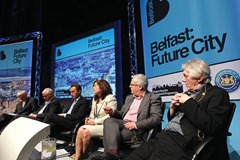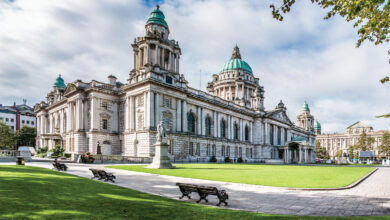City reflections: panel discussion
 Councillor Tim Attwood • Belfast City Council SDLP Party Leader
Councillor Tim Attwood • Belfast City Council SDLP Party Leader
Michael Parkinson asked earlier: “Is the council ready politically?” And I guess he asked this because of some of the societal issues we have had to face over the past six months. I would like to emphasise that for the first time in 40 years, we have had six party leaders come together to agree the Investment Programme for the city. We have not only stretched ourselves but also the officers [of the council] to determine what is needed socially and economically for Belfast. Despite some of the recent political difficulties over flags in the last six months, we have not been knocked off course and we did not stop talking to each other.
We are on the cusp of a unique opportunity. Politically, we are ready and we are getting new place-shaping and regeneration powers. Community planning will also give us the opportunity to have a single vision for the city, shared across all the sectors, community, business and public sectors. We cannot wait two years until 2015 when we get these powers. We need to start the process of engagement now with all the people in this room, and those who are not and may be less willing, with a view to having a shared vision, in draft form, by this time next year.
Geraldine McAteer • Chief Executive, West Belfast Partnership
Firstly, reform is a huge opportunity for this city and one that we should grasp with both hands. We should be proactive in our approach to implement it. Coming from a neighbourhood perspective, I think community planning is going to be vitally important for us in this city. The bill for social security benefits here in the North is £10 billion and, for me, community planning provides a foundation by which we can really address the deprivation we have in our inner cities and neighbourhoods.
In terms of ambitions, every child that goes to school in Belfast should come out at least being able to read and write. We need also to look at what the growth industries are and what skills we need to teach our young people to be able to access these jobs.
With community planning, and it will not happen overnight, our city leaders will take the lead in terms of city centre development and also work with the other groups, residents’ associations, our schools, and engage with people at a grassroots level to find out what exactly the issues and the challenges are.
In terms of Belfast City Council’s role, when they go out at a community level, they bring with them a certain gravitas and authority and a respect. They can pull together the different government departments, communities and the private sector and come up with realistic plans for each neighbourhood.
Maurice Kinkead • Chief Executive, East Belfast Partnership
The plan that’s going to come out of this needs to be ‘the plan’ and not ‘a plan’. Somebody said in our group today: “Well, if it will be the plan, then that’s good enough.” But actually, I think we need to turn that around. If it’s going to be the plan, then we have to make it good enough.
I’m more and more convinced that a partnership approach, regardless of how that’s structured, is the only way we can take this forward. We need the private sector, the community sector [and] the statutory sector, alongside the elected representatives, really working and driving this plan.
I think that most people commit to something that they enjoy so we’ve got to make this a process that people actually enjoy being part of and feel that they are contributing somehow to the future of the city.
We tend to put most of our effort in consultation into consulting with “important people” but actually the most important people are reasonably easy to consult with because they’re quite articulate.
The people who are most difficult to consult with are the people who do not feel they are articulate in the context that they’re in.
We need to have the mechanisms inside this process to allow angry people who feel they’re not articulate to somehow get across to us what they actually think the future of this city should be.
David Gavaghan • CEO, Titanic Quarter
For the future of the Titanic Quarter we have focused on three numbers: 2 million visitors by 2025, 10,000 people living and 30,000 people working there.
This city is just too small. It was a great city and we need to remember that the population of the city in the 1950s was at least twice the size of what it is today in the city centre. The world’s population has more than doubled in that time. The first simple figure would be 300,000 people by a certain date. A recent OECD report looked at 12 cities and one of the key issues identified was population attraction. This city has seen a declining population, and terrible things were done to this city, but the opposite is true for a growing population.
We live on an island, and whatever our political persuasion, you can never get away from that. This city has just enjoyed the most amazing outcome as a result of a major investment that everyone can be proud of: Titanic Belfast.
300,000 of the 800,000 visitors came from the Republic of Ireland.
We can express our opportunity for Belfast in terms of the global market and, on the eastern corridor of this island, we have potentially 4 million people. So that critical mass is a fundamental issue and the whole focus of our infrastructure and the relationship between Belfast and Dublin is central. Dublin has not been mentioned once today, which troubles me.
The third thing: I see two anchors for the city. The first is our young people. There are not enough young people in the room today and someone said: “If a city is fit for young people and children then it is fit for everybody.” The second anchor is women. When I first came here in 2004, generally most functions were full of elderly men. Today’s event is about 50:50. I have always thought of this as a divided society with the men and women issue bigger than the Catholic and Protestant issue.
Mike Smith • Principal, Rooney Smith Associates
We have a lot of actions and outcomes from the workshops and someone asked the question whether Belfast City Council had the capacity to do all of this.
I think over the last 10 years, there has been tremendous support and effort by Belfast City Council to attract investment.
Going forward, they need the support and engagement of all the other players otherwise all these actions identified will be impossible to achieve. For example, the Titanic Quarter is one example of the public and private [sectors] coming together – and Tim Attwood is right: the engagement needs to start now.
The big challenge in terms of spatial strategy is “Should there be a concentration in the city centre, or in the neighbourhoods or in a much wider area, which includes Titanic Quarter?” There has to be a balance and that has to be thought about. Investment in the Titanic Quarter will be complementary to, and support, what is happening in the city centre.





